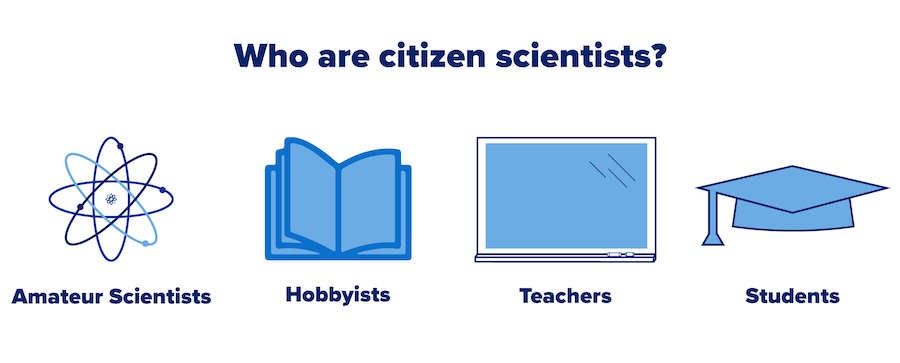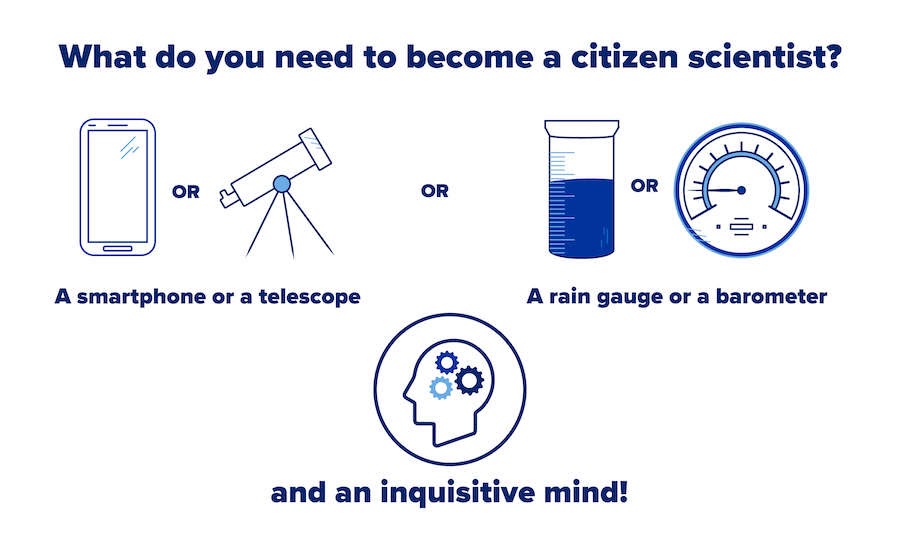How to Impact Your Community with Citizen Science, Even if You’re New to Data Analysis

How does a cell phone discarded into the trash in Seattle make its way to Florida? Further, why does that happen and how can we prevent it? Citizen scientists can help answer those questions.
Citizen science offers regular people ways to join in the process of scientific discovery. When amateur scientists participate in projects that measure air quality, monitor damage from storms, or track where their trash is going, they can help solve problems and shape a better future for their communities and society.
Through citizen science, volunteers contribute to research by providing rich and diverse forms of data that scientists at universities, government agencies, and in the private sector can apply to myriad projects. The process helps scientists save time, money, and effort by generating useful data from around the world. In turn, citizen scientists nurture their curiosity and, particularly in young budding scientists, develop their passions for STEM education.
Consider the cell phone example. Before starting a food supply company, Erin Baumgartner was a researcher at MIT. There, she oversaw a project in which sensors placed in garbage tracked refuse items from Seattle to points across the country. The sensors tracked some trash all the way to Florida.
Now, imagine what scientists might learn if millions of citizens worldwide dropped sensors into their garbage cans? The data could help change our approach to trash disposal.
In this article, we’ll explore how amateur scientists, hobbyists, teachers, and students can help create change by becoming involved in citizen science. We’ll also discuss projects and best practices, provide tips and resources, and help cultivate interest in being a part of the scientific community.

Citizen Science Projects
Citizen scientists participate in thousands of research projects around the world. At citizenscience.gov, the U.S. government’s official site for citizen science and crowdsourcing, nearly 500 projects are registered. These projects cover an array of fields including animal study, climate and weather, medicine, food, ecology, and many more. Other government agencies, such as the Environmental Protection Agency and the U.S. Forest Service, support their own projects. State, local, and independent organizations offer more ways to become a citizen scientist.
We’ll introduce some projects that are being conducted in various fields nationwide and in the New York area. Each of these projects offers opportunities for volunteers to collect data and participate in studies that are helping to improve our lives and communities.
Water Quality Projects
Volunteers safeguard our water supply by helping to measure bodies of water, test water sources for bacteria, and monitor our water’s overall health. This is vital research concerning one of the planet’s most precious natural resources.
Here are just a few water quality projects for which citizens can volunteer.
National and Regional Water Quality Projects
EPA Sanitary Survey App: The Environmental Protection Agency has developed a smartphone app that anyone can use to conduct sanitary surveys of marine environments and freshwater bodies.
Chesapeake Monitoring Cooperative: This organization distributes water-monitoring toolkits and a data-interpretation manual to volunteers eager to help maintain a healthy Chesapeake Bay watershed.
Stormwater Management Research Team: Also known as SMART, this University of Maine enterprise activates students and communities across the country to test stormwater for pollution.
Fresh Eyes on Ice: The University of Alaska Fairbanks is documenting worldwide conditions of freshwater ice through community-based volunteer teams.
CrowdHydrology: A crowdsourcing site run in part by the U.S. Geological Survey, CrowdHydrology relies on volunteers to report stream stage (the amount of water moving through a stream) and water levels, then makes that data publicly available.
Water Quality Projects in New York
The River Project: Volunteers collect weekly water samples from a variety of New York area sources for the Citizens’ Water Quality Testing program.
WAVE: The Department of Environmental Conservation recruits volunteers to collect biological data needed for assessing the quality of streams across New York state.
New York City Water Trail Association: This non-profit group, which promotes safe paddling and rowing in the city’s five boroughs, conducts an annual water quality testing program in which volunteers collect samples from the New York harbor region.
Lake George Association: The association that protects this popular recreational region in upstate New York trains citizen scientists to sample and assess water quality across the watershed.
Gotham Whale: This organization encourages people to report whale sightings while boating, fishing, kayaking, and photographing New York’s waterways.
Clean Air Quality Projects
Air pollution is one of the biggest environmental threats we face and can have debilitating impacts on our health. To better understand and improve our air quality, consider participating in one of these projects.
National and Regional Air Quality Projects
The Air Sensor Toolbox: The EPA offers a guide to installing, using, and reading sensors that measure pollutants in the air.
Smoke Sense: Another EPA-sponsored project, Smoke Sense crowdsources data via an app to determine the health effects of smoke from wildfires.
Air Quality Citizen Science: NASA sponsors this project in which volunteers deploy sensors and transmit the particle matter (or PM) data to NASA’s viewable air quality database.
Spidey Senser: This project aims to build a network of neighborhood air quality monitors using spider webs, which people collect and submit for testing to determine the amount of metals in the webs.
Project RISE: Carnegie Mellon University’s CREATE Lab invites volunteers to participate in a project designed to use Artificial Intelligence to recognize industrial smoke emissions (RISE).
Air Quality Projects in New York
The Air Sensor Toolbox: This EPA tool is important for measuring air quality not just in suburbs and rural areas, but also in densely populated cities such as New York.
New York City Community Air Survey: The city’s health department partners with Queens College, local neighborhoods, and citizen scientists to monitor air quality and pollutants across New York.
HabitatMap: This Brooklyn-based non-profit builds low-cost monitoring tools that empower organizations and citizen scientists to measure pollution in low-income communities and communities of color.
Biology Projects
Citizen scientists can be biologists and naturalists, helping researchers learn more about the living things around us, their habitats, and the threats they face. Many projects are available for those who seek to protect wildlife, and this field of citizen science can be particularly enlightening for kids who want to learn more about the plants and animals that share their communities.
National and Regional Biology Projects
Christmas Bird Count: The National Audubon Society sponsors this event as an annual bird census, for which thousands of volunteers count birds in a defined region over a 24-hour period.
FrogWatch USA: The Association of Zoos and Aquariums oversees this initiative that teaches people to listen for frogs from February-August and report their observations to a national database.
Never Home Alone: What else is living in your house? This project answers the question, as volunteers submit photos of the species (mostly insects) sharing their quarters.
Monarch Watch: The University of Kansas sponsors an annual program in which volunteers help track migration patterns and breeding seasons of monarch butterflies.
BeeSpotter: The University of Illinois runs a portal to which amateur bee-spotters can upload their photos and provide a demographic profile of bees regionally and, eventually, nationwide.
Biology Projects in New York
The Great Pollinator Project: Bee-watchers have helped this project record more than 225 species in New York City.
Moose Management: New York’s Department of Environmental Conservation has created a publicly curated photo gallery as part of its efforts to re-establish the state’s moose population.
New York Botanical Garden: The city’s horticultural wonder offers various citizen science projects involving native trees and plant species.
Celebrate Urban Birds: The Cornell Lab of Ornithology started this citizen science initiative to collect data regarding birds in urban areas and help introduce underserved communities to the birds around them.
New York Horseshoe Crab Monitoring Network: Volunteers help protect the New York Marine District’s horseshoe crab population by participating in this monitoring project.
Astronomy Projects
Space is no longer limited to researchers with access to satellites and observatory telescopes. Regular people have long looked up at the firmament and can contribute to various projects that seek to discover what else is out there.
National and Regional Astronomy Projects
Planet Four: Astronomers of all skill sets can help survey craters and other geological features on Mars.
Galaxy Zoo: Volunteers have helped Galaxy Zoo generate data on galaxies for more than a decade, outlining what those galaxies can teach us about the past and future of space.
Asteroid Data Hunter: Join NASA on its quest to identify asteroids that pose threats to Earth or those that might be potential human destinations.
Project PHaEDRA: Harvard University’s Center for Astrophysics seeks collaborators to help transcribe and digitize thousands of logbooks and other works produced by Harvard astronomers.
Cities at Night: This project, which is reminiscent of Google Maps, tasks volunteers to help catalog nearly 500,000 photos that astronauts have taken from the International Space Station.
Astronomy Projects in New York
Backyard Worlds: Planet 9: The American Museum of Natural History is partnering with volunteers to view animated images of space in search of anomalies that might lead to the discovery of our solar system’s ninth planet.
Amateur Astronomers Association of New York: The association contributes to research and conducts a busy schedule of classes, lectures, and observing events at points across the city. Volunteers also visit schools and organizations to discuss their work.
Gravity Spy: Syracuse University is one of this project’s education partners studying gravitational waves, which researchers call the “elusive ripples of spacetime.”
Citizen Science Games for Budding Scientists
Citizen science offers endless opportunities for discovery, making it a potential gateway to the STEM fields for young scientists. Participants learn how to perform experiments, collect and read data, work with new technology, and follow the scientific process.
Scientists, educators, and developers have created a broad catalog of citizen science games that entertain and inspire. And these games aren’t just for kids. Anyone with a science interest can play.
Water Quality Games
CrowdWater: Test your hydrology skills in this game, in which participants assess images of water levels via CrowdWater’s app.
AquaBot: PBS Kids’ SciGirls site includes several games that test scientific knowledge. In AquaBot, one mission is to design an underwater vehicle that is neutrally buoyant, meaning it neither floats nor sinks.
WaterSense: The EPA developed this PacMan-style game to teach kids (and adults) about water waste.
Groundwater Foundation: An organization dedicated to protecting groundwater, the foundation’s site offers several games and puzzles that teach kids about this vital resource.
Clean Air Quality Games
Smog City 2: The EPA and Sacramento Air Quality Management District created this air pollution simulator to instruct how individual choices, environmental changes, and other factors determine the cleanliness of our air.
Climate Kids: NASA’s kid-friendly site has a variety of games and activities, including one that depicts greenhouse gases as heroes and villains.
Air Quality Demo House: Take an interactive tour of the typical house, searching for ways to protect the air quality in each room.
Time Zone X: Restore historical events to their correct point in our timeline with Time Zone X, which includes a detailed section on air pollution.
Air Quality Baseball: Test your knowledge of air quality in this baseball-themed game.
Biology Games
River Run: Paddle downriver, collecting butterflies and other insects while learning about rivers and streams.
Plum’s Creature Connector: Explore ecosystems and solve puzzles to help plants and animals get the nutrients they need to survive.
Colony B: Players take charge of a colony of bacteria in this microbiology game that also collects data to help researchers understand the human gut.
Cancer Crusade: Help researchers at the Moffitt Cancer Center create new treatment strategies by developing your own treatment plan as a doctor from the future.
Astronomy Games
NASA Kids Club: NASA’s Clubhouse has a variety of games for kids to play as they learn about astronauts and space exploration.
Space Scouts: PBS Kids’ wide collection of games includes Space Scouts, in which kids learn how to build astronaut bases, develop a mission control from which to launch spaceships, and grow crops on other planets.
Explore Mars: Drive a rover and collect rocks on Mars in a game from NASA that introduces people to the Perseverance Rover that landed on the planet in 2021.
DSN Uplink-Downlink: NASA introduces the Deep Space Network in this game, which explains how the agency uses its three massive antenna complexes worldwide to communicate with spacecraft far from Earth.
Planet Plunge: Discover the composition of Jupiter’s atmosphere by launching a probe and keeping it operational in this game from the Space Science Institute.
Citizen Science Resources for Data Collection and Analysis
Millions of people can contribute to citizen science projects, offering a tremendous service to the research community, but only if they collect the data properly. How can volunteers make sure they don’t make errors that create a data gap? By adhering to the proper protocols when participating in scientific research.
Citizen scientists can take advantage of a variety of resources to help them navigate proper methods of data collection and analysis.
Water Quality Data Collection and Analysis Resources
The Citizen Science Quality Assurance Handbook: The EPA, which supports a variety of citizen science projects, developed this manual to help volunteers and organizations collect high-quality samples.
EarthEcho Water Challenge: Siblings Philippe and Alexandra Cousteau founded this nonprofit organization that provides tools, action guides, lesson plans, and test kits for participating in the challenge.
How’s My Waterway?: Join the conversation about healthy water across the country with this EPA database that details safe swimming zones, which fish are safe to eat, and who provides regional drinking water.
National Water Quality Monitoring Council: Learn more about water quality data, methods and protocols for procuring it, and how to monitor results.
Crowd the Tap: An EPA-funded project, Crowd the Tap promotes safe access to drinking water and provides instructions for its citizen ambassadors to conduct a chemistry test of water from their home pipes.
Clean Air Quality Data Collection and Analysis Resources
Understanding Air Sensor monitors: The EPA provides a comprehensive guide to installing and operating the sensors, collecting and evaluating their data, and devising test protocols.
Visualizing Air Quality data: Anyone, not just project participants, can view the air quality data measured by the Air Quality Citizen Science project. The site also provides detailed instructions for using the project’s defined sensor.
AirNow: This government website is a clearinghouse for air quality data, showing data for specific locations and providing an Air Quality Index that is important for people with health problems.
SciJinks: How is air quality measured? The National Oceanic and Atmospheric Administration explains that and more on its SciJinks site that is designed for students studying air quality, atmospheric conditions, and more.
Citizen Science best practices: This toolkit offers tips for planning, designing, completing, and crowdsourcing citizen science projects.
Biology Data Collection and Analysis Resources
Forest Service Planning Guide: The U.S. Forest Service has compiled a guide, webinar, and template for setting up your own citizen science project.
Wildlife Insights: Volunteers use camera traps to study how wildlife populations are changing, and this organization details the steps to deploying cameras, taking photos, and sharing them with the site.
iNaturalist: This large community collects observations about nature, discusses their findings, and encourages more naturalists to participate. There are plenty of tools and resources to join the observational process.
eBird: For birders who love to share, eBird makes it easy to track bird lists, photos, and sounds; follow its step-by-step protocols; and explore worldwide sightings.
BioBlitz: Communities come together to take a targeted snapshot of an area’s biodiversity by organizing what’s called a BioBlitz. National Geographic shares all the details for planning and conducting one.
Astronomy Data Collection and Analysis Resources
WorldWide Telescope Ambassadors Program: Harvard University researchers run this program that designs educational curricula, conducts research, and allows astronomers to connect their telescopes to the WorldWide Telescope visualization program.
International Astronomical Union: The IAU has compiled a guide to participating in astronomy research and also runs the International School for Young Astronomers.
Recoloring the Universe: Students use images from NASA telescopes to learn basic coding skills and understand astronomical data.
The Planetary Society: The organization, whose motto is “Know the cosmos and our place within it,” distributes plenty of content for amateur astronomers, including a guide to choosing their first telescope.
The Value of Citizen Science
William Redfield was a steamboat captain in the mid-1800s whose fascination with weather led him to become a meteorologist and the first president of the American Association for the Advancement of Science. He also is considered an innovator in citizen science for his work in tracking hurricanes.
Since then, citizen scientists have played an important role in conservation, contributed to Alzheimer’s research, and even found a lost spacecraft. The field of citizen science is “booming,” according to the online magazine Vox, as more and more people are turning their hobbies into beneficial research.
The best part is, citizen scientists don’t need degrees, research grants, expensive equipment, or experience analyzing data to enrich the scientific community. With some common tools (a smartphone or a telescope, a rain gauge or a barometer) and an inquisitive mind, anyone can practice citizen science.

Are you looking for more citizen science projects? Zooniverse and SciStarter are two of the top sites for citizen scientists of all ages and interests. Interested in learning more about data collection and analysis? Check out Columbia Engineering Data Analytics Boot Camp.

 Live Chat
Live Chat